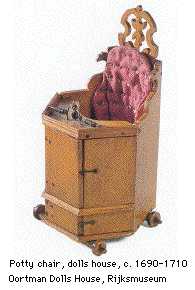 The
potty chair, 'een kinderstoel' stood in the Cooking kitchen,
Inde koockeucken. room D. If not yet potty trained, a child
was strapped in this potty chair. The lower padding, which had a
round hole in the middle, could be removed and washed.
The
potty chair, 'een kinderstoel' stood in the Cooking kitchen,
Inde koockeucken. room D. If not yet potty trained, a child
was strapped in this potty chair. The lower padding, which had a
round hole in the middle, could be removed and washed. The
potty chair, 'een kinderstoel' stood in the Cooking kitchen,
Inde koockeucken. room D. If not yet potty trained, a child
was strapped in this potty chair. The lower padding, which had a
round hole in the middle, could be removed and washed.
The
potty chair, 'een kinderstoel' stood in the Cooking kitchen,
Inde koockeucken. room D. If not yet potty trained, a child
was strapped in this potty chair. The lower padding, which had a
round hole in the middle, could be removed and washed.
Diary notes by Joan Huydecoper (1625-1704), who was mayor of Amsterdam, inform us about the upbringing of children in high society. His son Jantje Huydecoper was put into the potty chair:
When something was wrong with him, Huydecoper showed an active interest. He was dealing with Jantje's tummy ache which came up after he was given meat for the first time. The child turned out to be suffering from worms and Huydecoper informed after the cures: in the first place a balm for the stomach, and also 'something to hang in the beer which he is to drink'. But the best remedy seemed to him 'hot sweet milk which was poured into in the potty and shoved under him in the potty chair, so that the worms will smell the vapour and wiggle to his arse' (text from Kooijmans, Vriendschap, p, 161).
More on Huydecoper's love life.
Read about breast feeding and mothers milk.
Note : This object was part of the Vermeer-inventory as listed by the clerk working for Delft notary public J. van Veen. He made this list on February 29, 1676, in the Thins/Vermeer home located on Oude Langendijk on the corner of Molenpoort. The painter Johannes Vermeer had died there at the end of December 1675. His widow Catherina and their eleven children still lived there with her mother Maria Thins.
The transcription of the 1676 inventory, now in the Delft archives, is based upon its first full publication by A.J.J.M. van Peer, "Drie collecties..." in Oud Holland 1957, pp. 98-103. My additions and explanations are added within square brackets [__]. Dutch terms have been checked against the world's largest language dictionary, the Dictionary of the Dutch Language (Woordenboek der Nederlandsche Taal , or WNT), which was begun by De Vries en Te Winkel in 1882. In 2001 many textile terms have been kindly explained by art historian Marieke de Winkel.
Illustration taken from the recently published handbook on Dutch Doll Houses by Jet Pijzel-Dommisse,Het Hollandse pronkpoppenhuis, Interieur en huishouden in de 17de en 18de eeuw, Waanders, Zwolle; Rijksmuseum, Amsterdam, 2000, ill.152.
Luuc Kooijmans, Vriendschap en de kunst van het overleven in de zeventiende en achttiende eeuw. Amsterdam, Bert Bakker, 1997.
This page forms part of a large encyclopedic site on Vermeer and Delft. Research by Drs. Kees Kaldenbach (email). A full presentation is on view at johannesvermeer.info.
Launched December, 2002; Last update March 2, 2017.
Back to the Welcome page: click Welcome.